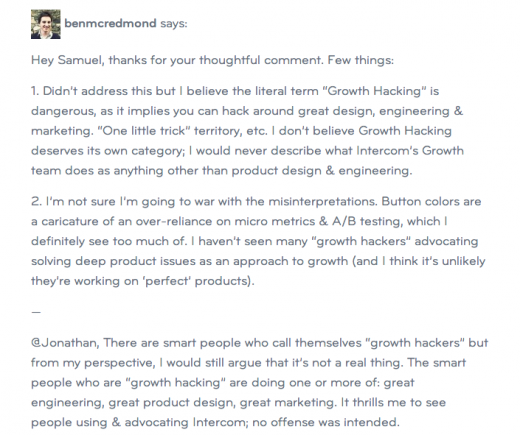
John Collins is the managing editor of InsideIntercom, the blog from Intercom focused on design, customer experience, start-ups, and the business of software. He was previously an editor and reporter for the Irish Times. This article was originally published on InsideIntercom.
One of my goals since joining Intercom has been to encourage more of the talented engineers, designers, product managers and business execs that work here to write for this blog.
To de-mystify the process and hopefully make it easier for them to contribute I drew up a set of principles that inform our writing at Intercom. I’d advise any company that has more than one person writing for its blog to consider drawing up a similar guide. At the very least it’s a useful exercise to think about what you want to achieve with your writing and how you intend to do it.
Here’s an edited version of that document distilling the points that are relevant to anyone running their own blog or writing for their job.
1. Speak with authority
If you know what you are talking about, you should be confident in your written communications. Just don’t be arrogant. Or patronize your readers.
Instead, have an opinion – preferably a strong, undiluted one. Offer new ideas and show you are knowledgeable in your domain. Here are some examples of what I mean:
Undiluted opinion
BAD: The initial release of Google+ was potentially weaker than it probably should have been, with some commentators saying it could possibly evolve to be a failure amongst the search giant’s stellar product line.
BETTER: Google+ was a disaster. No one used it. No matter how many new engagement metrics they invented, everybody knew it sucked. Even Googlers.
New ideas, show your knowledge
BAD: Will this product succeed? Who knows, but there’s a couple of concerns that it’s going to have to address first. We wish them the best of luck.
BETTER: I can see this working, but here’s two things I’d change…
Patronizing (and stating the obvious)
BAD: Whilst Facebook co-founder and CEO Mark Zuckerberg has a motto of “Move Fast and Break Things”, certainly product security is not an area that this oft-reported phrase applies.
BETTER: Security is one area where you don’t move fast or break things, no matter what Zuck says.
2. Be yourself
This is really a corollary to speaking with authority. Unless you are an exceptionally good writer, like so good that you should be touting for a book deal, you are not going to sound authentic trying to be someone else. And what’s the point of that anyway?
The New Yorker cartoon above was funny, and quite apt, in 1993. But in this hyper-social, over-sharing, always-on era with a few simple Google searches anyone can find out you are a dog, what kennel you came from, and where you went to dog training.
3. Be clear and concise
Write simply and clearly keeping in mind the audience you are writing for. In the case of Intercom that’s people in the software business, potential customers, potential new colleagues, etc.
You should keep your sentences and paragraphs short. Remember your are fighting for people’s attention, and they can be gone with a click, so get to the point.
It’s old school but use the 5Ws – who, what, where, when, why. You can also add how to that mix, if it’s relevant. Are you answering all those questions or are you making assumptions about what the reader knows?
One of the keys to being clear and concise is revising what you’ve written and editing it ruthlessly. This is definitely easier when you’ve taken a break, so when you’ve finished writing come back the next day and edit with a fresh eye.
It’s not unusual for an article to shrink by 15 to 20 percent at this point. That can seem weird if you are not already a regular writer; imagine wasting 20 percent of any other resource that you’d spent hours creating.
If you aren’t clear and concise in your writing it says something about the other things you produce. Des explains why here.
BAD: The horologists of Switzerland may not have been overly concerned at the details of Apple’s great watch unveil, but with the Milanese-bracelet option the Cupertino giant showed it had taken the time to study great timepieces of the past.
BETTER: Apple may not yet be ready to take on Swiss watchmakers. But the attention to detail on Apple Watch suggests a company which is in this for the long haul.
4. Present your ideas visually
The human brain is capable of processing images 60,000 times faster than text. Which goes some way towards explaining why content with relevant images gets 94 percent more views than text only content.
We try to produce as many original images as possible for posts on Inside Intercom. Fortunately we have several talented visual designers on staff including Frantisek, who is responsible for producing the majority of original images you see here, including the cupcake image above.
There are also lots of sites where you can get free or low cost images which don’t look like trite stock photos.
BAD: Earlier this year we published a post about how the technology sales process is changing. It was entitled Time for Sales to Call a Truce With Customers. The lazy way to illustrate that post would have been with an image like this:
BETTER: An image of two business people shaking hands would have fulfilled the requirement to have a picture with every post. But would it have added anything to your understanding of the piece?
Instead we briefed one of our designers, Jennie, and she created the image below. Straight away you know the post is going to address the way that SaaS has changed the way technology is sold and three of the key things that have changed.
It’s not always possible to put the time and effort into creating images like this but when you do it’s well worth it.
5. Focus on quality over quantity
This one is very specific to Intercom but I think it’s worth explaining. News is one area of content creation where there isn’t any long tail to speak of. Break a news story, or even just add some insightful commentary on the events of the day and you’ll generate a lot of traffic. Particularly if you make it onto Techmeme or the front page of Hacker News.
But the following day that traffic will have dropped to 10 percent or less. Day three? We’re talking a trickle.
Rather than climbing onto that treadmill where you constantly have to produce big hits Intercom tries to produce “evergreen” content that has a long shelf life. That takes longer to achieve results but sticking to this strategy has paid off in spades.
If you still think you need to churn out the content every day, read this. About 27 million pieces of content are published every day, but 60 to 70 percent of content goes unused.
BAD: Writing a quick and dirty news story linking to the latest leaked video of Windows 9
BETTTER: Writing a considered and informed piece about the design challenges facing Microsoft on Windows 9
6. Write intriguing headlines and headings
Headlines are where you sell what comes next. Your readers have limited time and there are competing demands on it – in many cases all they see is the headline before they decide to click through or not. A good headline helps you stand out from the noise. Kevin Clark has some good tips here.
We avoid sensationalist headlines or ones that have been written purely to maximise clicks. So here’s some headlines that you won’t ever see on Inside Intercom:

However we will write strong headlines, like these:
7. Punctuation matters

Punctuation really matters. Because bad punctuation has the power to make you look really, really silly.
In fact all grammar is important, so if you are serious about this buy a style guide like the best-selling AP Stylebook, which we use.
8. Engage with your readers
At the risk of breaking our rule about cliches, when you start writing a blog or any other public-facing communications, you have to be prepared to get into a conversation. Yes, there are times it will get ugly and messy, but if it doesn’t you’re not following our guideline about Speaking With Authority.
If someone comments on something you have written try to engage with them in as timely a manner as possible. If someone is clearly trying to bait you into a flamewar, a simple and polite “thanks for your feedback” will suffice.
Ben recently wrote a post that generated a little controversy. Tensions run high in these situations. But responding respectfully helps generate a reasonable conversation.
BAD: “What gives you the right to criticize me? You’ve only got 50 Twitter followers and if your comment is anything to go by you have no idea what you’re talking about.”
BETTER: “Hi Adrian. Thanks for taking the time to leave a comment on the blog. Although I can understand where you are coming from, that’s not actually what I was saying…”
What content strategies have worked for you? We’d love to hear your story in the comments below.
Read next: Setting the stage: Killer user onboarding starts with a story
Get the TNW newsletter
Get the most important tech news in your inbox each week.











